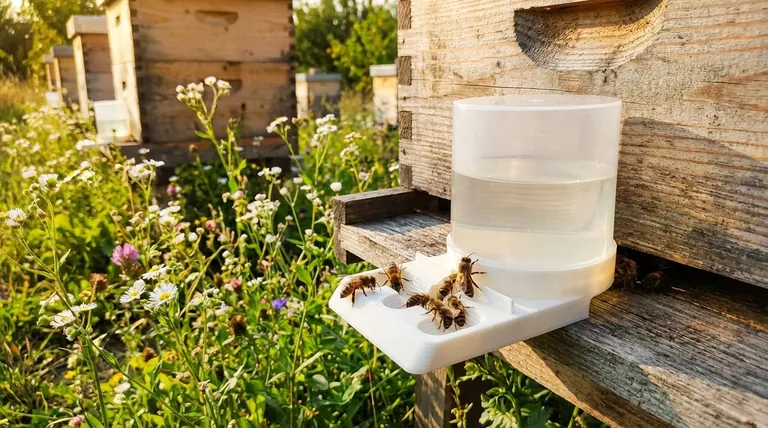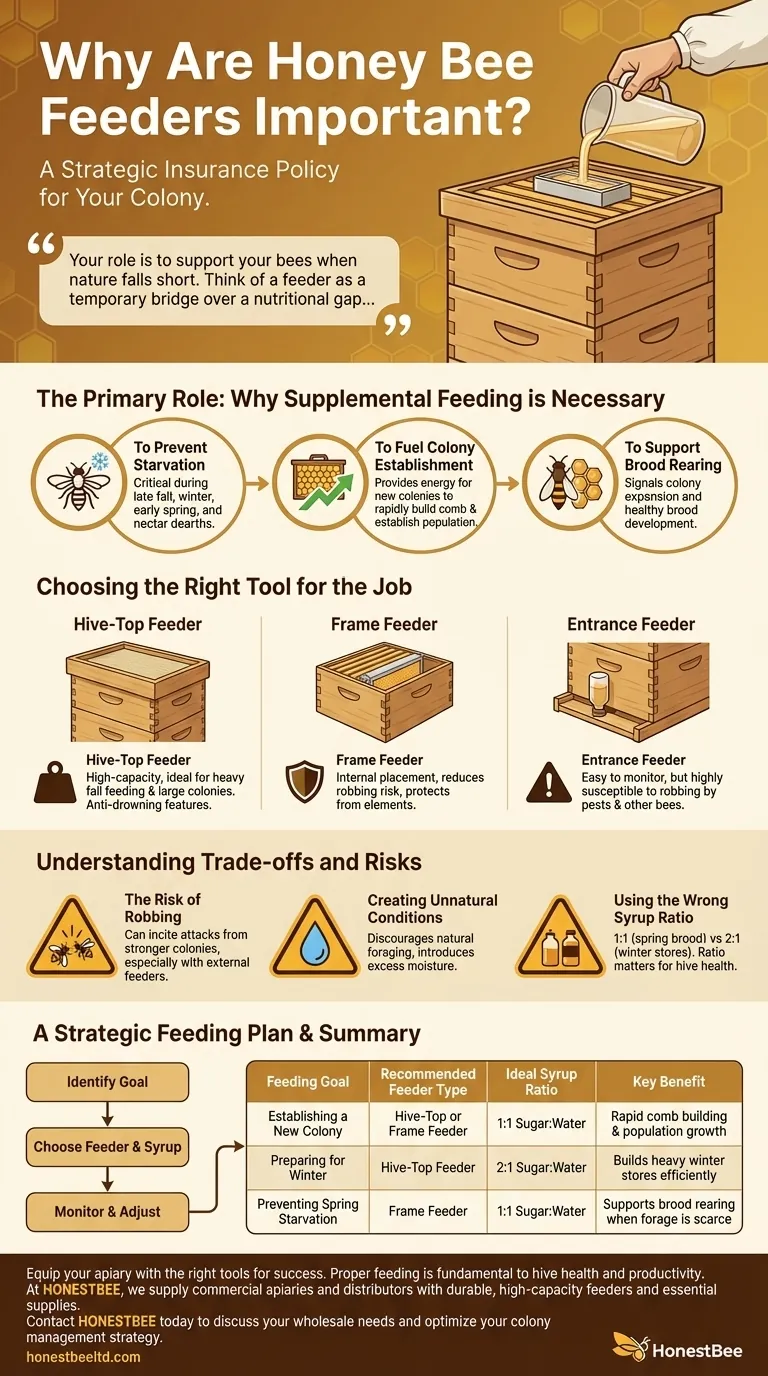At its core, a honey bee feeder is a strategic insurance policy for your colony. It is a tool designed to provide supplemental nutrition—typically a sugar syrup—when natural nectar sources are scarce. Feeders are critical for preventing starvation, fueling growth during establishment, and ensuring the hive has the resources needed to survive challenging periods.
Your role as a beekeeper is not to replace nature, but to support your bees when nature falls short. Think of a feeder as a temporary bridge over a nutritional gap, ensuring your colony's survival and strength without creating dependency.

The Primary Role: Why Supplemental Feeding is Necessary
A feeder's importance stems from its ability to solve specific, time-sensitive problems that a colony cannot overcome on its own. It is a targeted intervention, not a permanent food source.
To Prevent Starvation
The most critical function of a feeder is to prevent a colony from starving. This is most common during late fall, winter, and early spring when there are no flowers blooming and the bees have consumed their honey stores.
A period of drought or unseasonable weather, known as a nectar dearth, can also create a sudden food shortage even in summer, making a feeder essential for survival.
To Fuel Colony Establishment
A new colony, whether from a package or a nucleus hive, faces an immense task: building wax comb, raising young bees (brood), and gathering food.
Providing a 1:1 sugar syrup gives them a readily available energy source, allowing them to rapidly build out their hive and establish a healthy population before the main nectar flow begins.
To Support Brood Rearing
A queen bee's laying rate is directly tied to the resources coming into the hive. Consistent incoming "nectar," even from a feeder, signals to the colony that it's a good time to expand.
This supplemental feeding supports healthy brood development, ensuring the colony can raise the next generation of bees and maintain its strength.
Choosing the Right Tool for the Job
The type of feeder you use impacts its effectiveness and risks. Each design serves a different purpose based on the season and the goal of the feeding.
Hive-Top Feeders
These are high-capacity feeders that sit directly on top of the uppermost hive box. They hold a large volume of syrup and often include anti-drowning features, making them ideal for heavy fall feeding or supporting large, rapidly growing colonies.
Frame Feeders
A frame feeder is a thin, plastic container that takes the place of one or two frames inside the hive box. This internal placement reduces the risk of attracting pests or bees from other hives (robbing) and protects the syrup from the elements.
Entrance Feeders
Also known as Boardman feeders, these small containers fit into the hive's entrance. They are easy to monitor and refill, but their external placement makes them highly susceptible to robbing by other bees and pests. They are best used for small colonies in warm weather when robbing pressure is low.
Understanding the Trade-offs and Risks
While essential, feeding is not without its risks. Improper feeding can create more problems than it solves.
The Risk of Robbing
Feeders, especially external ones, can signal a free meal to nearby honey bees, wasps, and ants. This can incite robbing, where a stronger colony attacks a weaker one to steal its resources, often resulting in the death of the weaker hive.
Creating Unnatural Conditions
Feeding should stop when a natural nectar flow begins. Continuing to feed can discourage bees from foraging naturally. It also introduces excess moisture into the hive, which the bees must work hard to dehydrate, increasing their workload.
Using the Wrong Syrup Ratio
The syrup recipe matters. A 1:1 ratio (by weight) of sugar to water mimics natural nectar and stimulates brood rearing, making it ideal for spring.
A 2:1 ratio of sugar to water is much thicker, requires less processing by the bees, and is better for building winter stores. Using a thin 1:1 syrup in the fall can add too much moisture to the hive at a time when ventilation is reduced.
A Strategic Feeding Plan for Your Goal
Your decision to feed should be driven by a specific, observable need within the hive.
- If your primary focus is establishing a new colony: Feed a 1:1 syrup continuously until the bees have built out comb on at least 80% of the frames in their first hive box.
- If your primary focus is preparing for winter: Feed a heavy 2:1 syrup in the fall after the last major nectar flow has ended to ensure the hive has adequate winter stores.
- If your primary focus is preventing spring starvation: Check hive weight. Only feed a 1:1 syrup if the colony feels light and natural forage is still weeks away.
Ultimately, a honey bee feeder is a powerful tool for responsible hive management when used with precision and purpose.
Summary Table:
| Feeding Goal | Recommended Feeder Type | Ideal Syrup Ratio | Key Benefit |
|---|---|---|---|
| Establishing a New Colony | Hive-Top or Frame Feeder | 1:1 Sugar:Water | Rapid comb building & population growth |
| Preparing for Winter | Hive-Top Feeder | 2:1 Sugar:Water | Builds heavy winter stores efficiently |
| Preventing Spring Starvation | Frame Feeder | 1:1 Sugar:Water | Supports brood rearing when forage is scarce |
Equip your apiary with the right tools for success. Proper feeding is fundamental to hive health and productivity. At HONESTBEE, we supply commercial apiaries and beekeeping equipment distributors with durable, high-capacity feeders and essential supplies through our wholesale-focused operations. Let us help you build a resilient and thriving operation.
Contact HONESTBEE today to discuss your wholesale needs and optimize your colony management strategy.
Visual Guide

Related Products
- HONESTBEE Entrance Bee Feeder Professional Hive Nutrition Solution for Beekeeping
- HONESTBEE Professional Hive Top Bee Feeder Feeding Solution
- Professional Hive Front Entrance Bee Feeder
- Classic Boardman Entrance Bee Feeder Hive Front Feeding Solution
- In-Hive Dual Compartment Frame Bee Feeder for Targeted Colony Nutrition
People Also Ask
- What are the different types of honey bee feeders? Choose the Right Feeder for Your Hive
- What are the common types of honey bee feeders? Choose the Right Feeder for Your Hive
- How does the entrance feeder method work? A Guide to Simple But Risky Hive Feeding
- What is an entrance feeder? A Guide to Its Simple Design and High Robbing Risk
- How to make an entrance feeder for bees? A DIY Guide for Safe & Effective Feeding



















